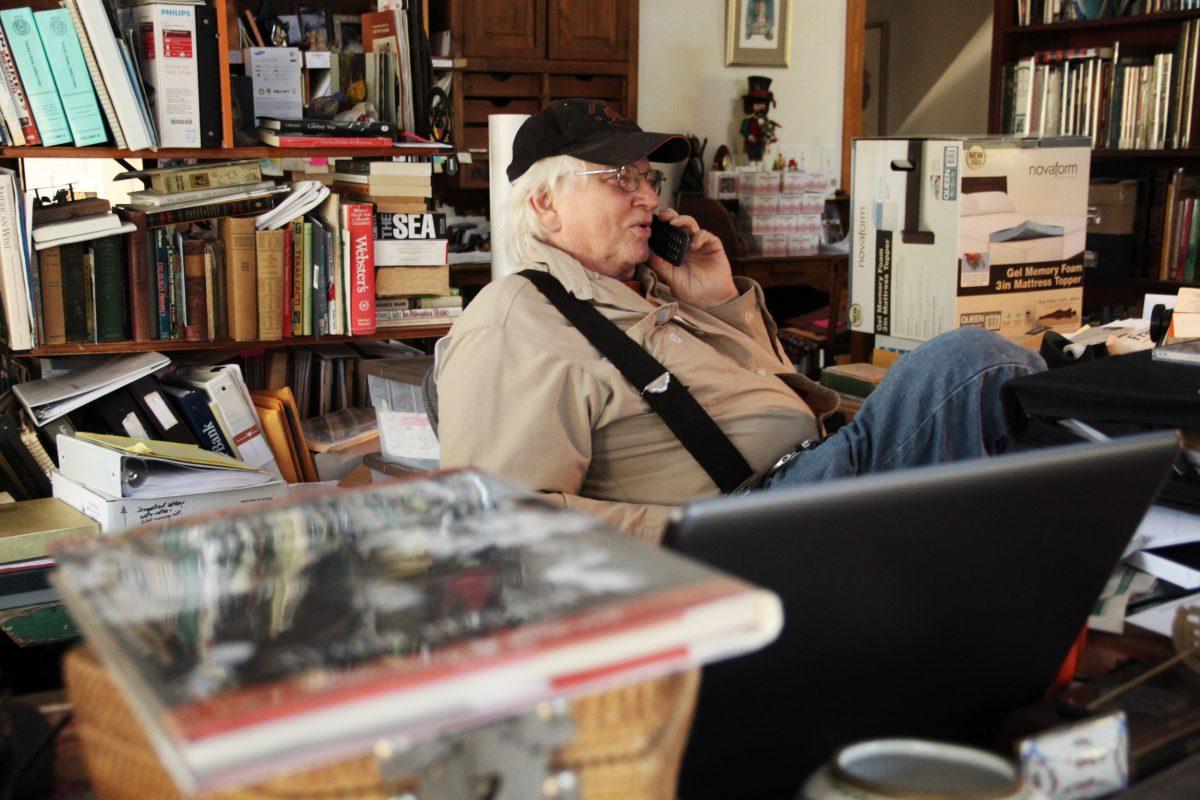Story and photos by Mikhaela Locklear
Editors’ note: This story was written in October 2013. We present it here to honor Harley Clark, who died Thursday at his farm outside of Austin.
It was a bumpy ride down the washed-out dirt road to the little house in Dripping Springs. The home sat in the midst of the greenery that I would soon find to be filled from floor to ceiling with hundreds of books – ranging in subject from gardening to Darrell K. Royal – and knick-knacks that could have only been collected over a lifetime.
“Young lady, would you like a 7UP?” I am asked as I admire the large, self-sustainable rainwater collection tanks that supply water to the little house. He notices and adds, “The next step would be to get some solar panels in that field over there so we can be completely self-sufficient.”
On a late Saturday afternoon, amid towers of books, Harley Clark took me back to that legendary day in 1955 when he created the iconic “Hook‘em Horns” sign, the ultimate symbol of the University of Texas at Austin.
We walk into the little house and are greeted by Earl, a basset hound, and Evie and Wilma, both dachshunds. I take a seat at his desk littered with papers, books and a Longhorn snow globe that particularly catches my eye. “I get invited to campus to tell the story live, and I enjoy that,” Clark says. “People seem to enjoy hearing it, so I guess I’ll keep doing it until I wear out my welcome.”
It has been 58 years since the sign’s inception, yet Clark tells the story with eloquence, as if it had happened yesterday, and a smile on his face. “The year was 1955. I had been elected head yell-leader by the student body and we were coming up on the TCU game.We had, some might say, a mediocre team,” Clark adds.
His job as head yell-leader was to help the students “make up in spirit what [they] lacked in talent.” Clark had to come up with something to boost morale. Other universities in Texas, especially UT’s rivals, had started using hand signals at games. “A fellow by the name of Henry Pitts … P-I-T-T-S,” he spells it out for me to make sure I get it right in my notes, “had got me aside and said, ‘You know, if you do your hands like this you can make it into what appears to be a Longhorn.’”
Clark asked his fellow students for opinions. “Most of them told me they didn’t think it was good idea and it would never take … How much they knew, huh?” He glances in my direction with a smirk. That Friday night, at the pep rally, Clark introduced the hand sign to the crowd. “You could see them kind of fooling around trying to arrange their fingers,” he says.
As he lies back in his chair, Clark begins his favorite part of the story.
Then Dean Arno Nowotny came up to Clark after the rally. “He grabs my right elbow, forcefully, and pulls me around toward him. He looks straight up in my face, and I look down at him. He was a short, little fellow,” Clark recounts. The dean was furious Clark hadn’t checked with him before proclaiming the hand signal. He was too late though. “The hand signal was out of the box,” as Clark puts it.
Clark claims to have told Dean Nowotny, “You need to look on the bright side of things. Instead of our mascot being a longhorn, it could have been a unicorn!” Clark and I laugh.
At the game the next day, Clark says he could tell that his simple proclamation had had quite an effect. “The students in the student section were doing it, and, right around halftime, the signal had crept around the horseshoe [of the stadium],” he says.
After graduating from UT, Harley Clark went on to be a successful judge for many years but has since retired and found new prospects.
Now, he gardens. His connection to “the Big Mother,” his name for Mother Nature, is most important to him. He has multiple gardens on his property where he grows “all the veggies,” as he puts it. His favorite vegetables to grow are tomatoes. “Tomatoes and I get along … I’m in love with tomatoes,” he explains.
He slowly gets up from his desk chair and looks out the large windows that line the back wall of the little house. He’s decided to show me his zinnias before I go.
We take another bumpy ride through his property down to the flower garden. He helps me out of the car, and we walk into a sea of pink, orange and purple beauty. He takes a pair of scissors out of his pocket and begins to search for the perfect bloom.
A bee buzzes by and, and Clark greets it with a “hello.”
After meticulously combing through the sea of colors, he has picked the perfect four flowers. He places them in a vase, already ready in his car, and hands it to me as a gift. We climb back into the four wheel drive Toyota and begin to head back to my car. As we’re driving, a question I had not yet asked occurs to me.
“How many acres do you have here Mr. Clark?” I ask.
To which, he simply replies, “Forty.”


















































